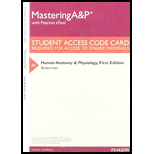
The central nervous system is responsible for:
a. integrative functions.
b. sensory functions.
c. motor functions.
d. Both b and c are correct.
Introduction:
In human beings, the central nervous system consists of the brain and the spinal cord. Brain is a large and delicate organ, which is placed inside the cranial cavity. It contains several ventricles filled with protective CSF (cerebrospinal fluid). The four divisions of the brain are cerebrum, diencephalon, cerebellum, and brainstem, which connect the brain to the spinal cord.
Answer to Problem 1CYR
Correct answer:
The central nervous system is responsible for integrative functions.
Explanation of Solution
Explanation for the correct answer:
Option (a) states that integrative functions are carried out by the central nervous system. Integrative functions include higher mental functions, such as use of language and learning, maintenance of homeostasis, planning and monitoring movements, decision making, and interpretation of sensory stimuli. These functions are exclusively performed by different components of CNS. Hence, option (a) is correct.
Explanation for the incorrect answers:
Option (b) states that sensory functions of the body are performed by the CNS. These functions include detection of all the sensory stimuli from the sense organs, which is performed by the nerves of peripheral nervous system. So, option (b) is an incorrect option.
Option (c) states that motor functions are performed by the CNS. The peripheral nervous system (PNS) consists of motor neurons. All the motor functions of the body, such as stimulation of muscle contraction, or secretion by a gland are thus performed by the peripheral nervous system. So, option (c) is an incorrect option.
Option (d) states that both sensory and motor functions are performed via the CNS. However, they are performed by the PNS, which consists of several cranial and spinal nerves. So, option (d) is an incorrect option.
Hence, options (b), (c), and (d) are incorrect.
Thus, it can be concluded that integrative functions of the body are performed by the central nervous system (CNS). On the other hand, sensory and motor functions of the body are not performed via the central nervous system, as they involve PNS.
Want to see more full solutions like this?
Chapter 12 Solutions
Mastering A&p With Pearson Etext -- Valuepack Access Card -- For Human Anatomy & Physiology
Additional Science Textbook Solutions
Human Anatomy & Physiology (11th Edition)
Essentials of Genetics (9th Edition) - Standalone book
Brock Biology of Microorganisms (15th Edition)
Campbell Biology in Focus (2nd Edition)
Campbell Essential Biology with Physiology (6th Edition)
Biology: Life on Earth (11th Edition)
- The concept of “labeled lines” states that each nerve input to the brain reports only a particular type of information, such as auditory versus visual information. Does this happen because the nature of the nerve fibers conveying the information is unique or because the nature of the brain location where the signals are received is unique? How do you know this?arrow_forwardCoordination and timing of movements and balance are functions of which of the following brain structures? a- basal ganglia b- motor cortex c- midbrain motor centers d- cerebellumarrow_forwardWhich part of the nervous system directly controls the digestive system? a. parasympathetic nervous system b. central nervous system c. spinal cord d. sensory-somatic nervous systemarrow_forward
- The subdivision of the brain that does not initiate somatic motor movements, but rather coordinates and fine-tunes those movements, is the a. medulla oblongata. b. cerebrum. c. cerebellum. d. diencephalon.arrow_forwardWhen the dentist gives you a lidocaine injection before drilling into a tooth, she numbs a nerve in your mouth, which is a A)cranial nerve and part of the peripheral nervous system. B)cranial nerve and part of the central nervous system. C)spinal nerve and part of the peripheral nervous system. D)spinal nerve and part of the central nervous system.arrow_forwardWhat are the two primary functions of the nervous system?arrow_forward
- The brain knows whether an incoming nerve impulse is light, sound, or pain because of thea. nature of the sensory receptor.b. frequency of the sensory signal.c amplitude of the sensory signal.d. wiring to specific CNS locations.arrow_forwardThe feel of your pencil on your fingertip is carried through the thalamus to the cortex. Which part of the cortex does this information reach first? a. hippocampus b. limbic cortex c. parietal lobe d. frontal lobe Which of the following is NOT a catecholamine? a. norepinephrine b. serotonin c. epinephrine d. dopaminearrow_forwardMake a diagram of the Peripheral nervous system?arrow_forward
- Which of the following statements about the cerebral cortex is FALSE? A) The cortex in primates (and especially humans) has more sulci and gyri than in lower mammals. B) The neurons in the cortex are organized into groups of 80 to 100 interconnected cells, arranged in vertical columns. C) The human cortex is arranged into six layers of neurons (although a particular layer may be absent in some areas). D) The cerebral hemispheres are organized into five lobes, named after the skull bone covering them.arrow_forwardIn order to function, does the nervous system depend on other systems such as the muscular system or the respiratory system?arrow_forwardIn a syndrome called word blindness, a person loses the ability to read (even single letters), although the person can still see and speak. What is a possible neurological explanation? That is, can you imagine a pattern of brain damage that might produce this result?arrow_forward
 Concepts of BiologyBiologyISBN:9781938168116Author:Samantha Fowler, Rebecca Roush, James WisePublisher:OpenStax College
Concepts of BiologyBiologyISBN:9781938168116Author:Samantha Fowler, Rebecca Roush, James WisePublisher:OpenStax College


